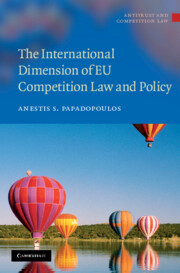Book contents
- Frontmatter
- Contents
- List of Tables
- Acknowledgements
- Abbreviations
- Table of Cases
- Table of Legislation
- Table of Treaties and Agreements
- 1 Introduction, Structure of the Book and Method
- 2 The National and International Dimensions of Competition Law and Policy
- 3 Bilateral Enforcement Cooperation Agreements
- 4 Bilateral Trade Agreements which Include Competition Provisions
- 5 Plurilateral Regional Agreements which Include Competition Provisions
- 6 The Role of Competition Law and Policy of the EU in Multilateral Negotiations on Competition
- 7 Conclusions: Main Findings of the Study
- Appendix 1 Economic Theories Applied to Competition Law
- Appendix 2 General Information about Plurilateral Regional Agreements
- Bibliography
- Index
2 - The National and International Dimensions of Competition Law and Policy
Published online by Cambridge University Press: 10 November 2010
- Frontmatter
- Contents
- List of Tables
- Acknowledgements
- Abbreviations
- Table of Cases
- Table of Legislation
- Table of Treaties and Agreements
- 1 Introduction, Structure of the Book and Method
- 2 The National and International Dimensions of Competition Law and Policy
- 3 Bilateral Enforcement Cooperation Agreements
- 4 Bilateral Trade Agreements which Include Competition Provisions
- 5 Plurilateral Regional Agreements which Include Competition Provisions
- 6 The Role of Competition Law and Policy of the EU in Multilateral Negotiations on Competition
- 7 Conclusions: Main Findings of the Study
- Appendix 1 Economic Theories Applied to Competition Law
- Appendix 2 General Information about Plurilateral Regional Agreements
- Bibliography
- Index
Summary
Origins of competition law
The first known restrictive trade agreement to be examined under common law by the English courts was Dyer's Case in 1414 where the court denied the collection of a bond for John Dyer's breach of his agreement not to ‘use his art of dyer's craft within the town … for half a year’. Since then, and throughout the following decades, a number of cases were decided by the English courts, and this gradual development of competition-related jurisprudence created an environment in which judicial principles were transformed into statutes. It was England once again which went even further and adopted statutory rules related to restrictive business practices. The Statute of Monopolies was adopted in 1624, following the 1602 decision in the Darcy v. Allein case, in which the King's Bench unanimously held as void the sole right that Queen Elizabeth I granted to her groom Darcy to import playing cards into England.
The main question the courts had to address was whether to declare as void any restrictive trade agreement for reasons relating to fairness of trade, or whether a distinction should be made between naked and ancillary (otherwise general and particular) restrictions to trade, where the former would be declared void de facto but the latter should be analysed in order to evaluate their positive and negative effects on the market and then a decision made as to their voidness.
- Type
- Chapter
- Information
- Publisher: Cambridge University PressPrint publication year: 2010
- 2
- Cited by

